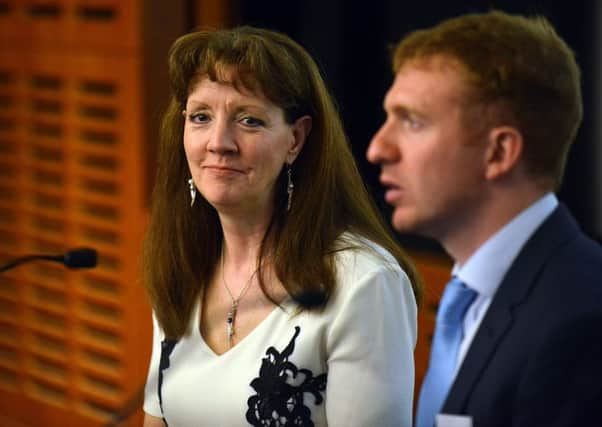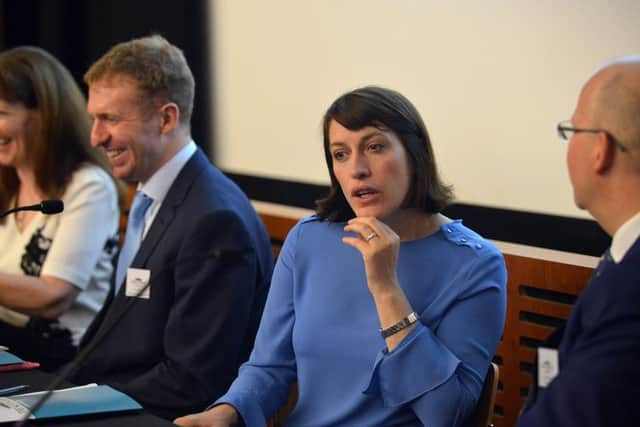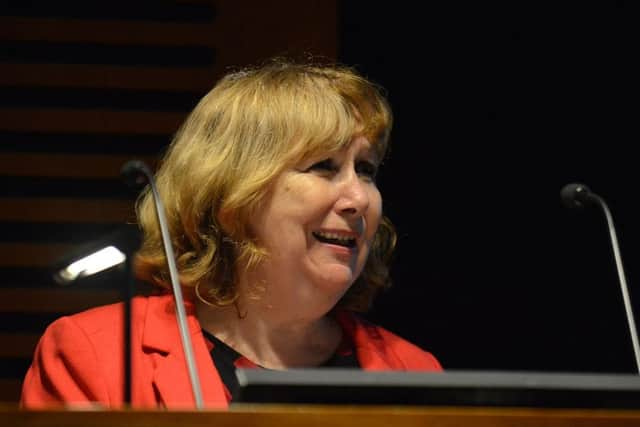Promoted content: Time for community pharmacies to build on potential


Community pharmacies are “hiding in plain sight” across Scotland and have significant potential to deliver a far wider range of services to take pressure off GPs and other health professionals.
That was a key message from Community Pharmacy: Supporting Patients, Delivering for Scotland, a policy conference held at the National Galleries of Scotland this week.
Advertisement
Hide AdAdvertisement
Hide AdThe “hiding in plain sight” comment came from Professor Rose Marie Parr, chief pharmaceutical officer for Scotland, who suggested that while community pharmacies were very visible on our high streets, public awareness of what they could do was not as great as it should be.


Parr set the agenda for the discussions by noting people were living longer but with a wider range of health conditions – and the status quo was not an option for primary care.
“We need safe, effective, person-centred healthcare which supports people to live as long as possible in their home or a homely environment. Delivering primary care in communities has to be at the heart of the new NHS, to help people stay in that homely setting,” she said.
“We want people to be engaged in their own disease management, to understand their own medicines. Community pharmacy has a huge contribution to make.”
This was reinforced by Sinéad Power, team leader (innovation and improvement) in the Scottish Government’s primary care division.


She said: “The world is changing, demand is increasing and people want care close to home.”
Power said close collaboration at local level between multi-disciplinary teams of healthcare professionals was crucial.
Parr said things had to improve: “Pharmacy and other primary care services can work together better.”
Advertisement
Hide AdAdvertisement
Hide AdShe added that too many areas of communication within primary care were still paper based – “and that’s not good enough”.


Andrew Buist, deputy chairman of the Scottish GP committee of the BMA, said it was time to look at health smartcards as the current system was very inefficient.
“We have a lot to learn and need to embrace the technology everyone has in their wallet or jacket pocket. We still do too many things the old way.”
He said there were many areas where GPs’ time was not well used and workloads could shift to community pharmacies.
“There is much more to do and GPs feel maxed out; 28 per cent of practices are carrying vacancies and the problem is getting worse as there are lots of doctors retiring or close to retiring – and not enough young doctors wanting to come in.”


Buist added: “We need to give up some of our current tasks and concentrate on what we do best.
“We want to move out of chronic disease management, health promotion, public health and immunisation.
“This is not our skill set and these areas should move to an integrated joint board and there may be opportunities for community pharmacists.”
Advertisement
Hide AdAdvertisement
Hide AdHe estimated he spent 30 to 60 minutes repeat prescribing every day, often being asked to dispense items like dressings, eye-drops, foodstuffs and colostomy products, which he considered “a very poor use of my time”.
Buist said there were many areas where GPs needed pharmacists’ support, including medicines reconciliation, polypharmacy reviews [for patients on multiple medicines] and dealing with high-risk medicines.
Community pharmacists were receptive to taking on more responsibilities, but warned they had to be rewarded appropriately for taking on more work – and that they too needed to free up time, allowing them to spend more time on patient consultations.
Power said all healthcare professionals “were under a huge amount of pressure”, adding: “It takes time to make improvements. Primary care is part of a very complex wider agenda.”
Looking at what had worked well, Parr said the Pharmacy First pilot scheme had been “a great experiment” in showing what could be achieved by community pharmacists in managing common clinical conditions. [Jonathan Burton gave detailed findings from the project – see panel right.]
Education and training were crucial in helping pharmacists take on more responsibilities, said Parr. “Competence and professionalism are very important in enabling this [transition] to happen in future.
“And public expectations of all healthcare professionals are really high. Trust is very important and it’s not just about having the skills, it’s about how to apply them,” she said.
Ed Clifton, a senior health economist with Healthcare Improvement Scotland, also raised the point about rising public expectations.
Advertisement
Hide AdAdvertisement
Hide AdThis was one of a number of factors creating huge budgetary pressures in primary care – including the ageing population and consequent rise in long-term conditions. [The number of over-65s in Scotland will rise from about 930,000 to 1.47 million by 2035].
“We all want to see greater technological development in healthcare but if we have that, something has to give because of the cost implications,” said Clifton.
He thought there were clearly areas within 24.2m annual GP consultations in Scotland that didn’t need to be dealt with by family doctors and asked: “Can we shift the balance of care from GP surgeries to community pharmacies? We have a highly-skilled professional workforce which is under-utilised.”
The Minor Ailments Service (MAS) was part of the shift in the balance of care, said Clifton.
Evidence showed this was a cost-effective approach; research by the Royal Pharmaceutical Society suggested the cost of treating patients for minor ailments in a community pharmacy was around £29, against £82 in a GP surgery.
“The key opportunity is around partnership working with patients and other primary healthcare providers,” said Clifton.
“But how can we achieve benefits without compromising quality? And if there are more community pharmacists but no fewer GPs, there are questions about cost-effectiveness.”
Clifton concluded: “With NHS and GP resources stretched, community pharmacies have a lot to offer and could lead to resource savings to ease funding challenges.”
Advertisement
Hide AdAdvertisement
Hide AdHowever, concern was expressed that the “elephant in the room” was the lack of uniformity and the danger of “patchwork provision” of services by community pharmacies across Scotland ’s health boards in areas like MAS and Pharmacy First.
Power said the extension of pilot schemes was important to the transformation of primary care services.
“Part of the whole system approach is effective trialling. But it’s not about what’s right for Dumfries & Galloway or Forth Valley, it’s about how we can pull that learning out and share it nationally.
“We need to constantly challenge ourselves, to innovate and to spread good practice.”
Pilot shows the way in patient care
Jonathan Burton revealed positive results from the Pharmacy First pilot in the Forth Valley area.
Burton, a community pharmacist at Stirling University, said the scheme had focused on two specific condition; urinary tract infections (UTIs) and impetigo.
With relatively limited publicity, patients with symptoms of UTIs or impetigo were encouraged to visit their community pharmacy as their first port of call.
The first five months of the pilot scheme this year saw 897 presentations for UTIs; 76 per cent of patients received antibiotics, 15 per cent were referred to a GP or out-of-hours service and 9 per cent were being given advice on fluids, pain relief, etc.
Advertisement
Hide AdAdvertisement
Hide AdImpetigo saw 181 patients come forward, with 79 per cent treated with antibiotics, 6 per cent referred and 15 per cent advised on self-care.
Burton said formal evaluation by Aberdeen University would be published very soon, but patient and GP feedback was very good to date.
He thought awareness of community pharmacy in general was “really growing” and said there was a desire from community pharmacists to integrate more clinical skills into their workload.
“Patients need to know what you can do, but equally they need to know the limitations of those skills,” said Burton.
“Quality referrals to other healthcare professionals are really important.”
He concluded: “We have 1250 NHS walk-in centres in Scotland, also known as community pharmacies.
“We can improve, we can collaborate better, but the network of community pharmacies exists and we need to support it to help it do the best job it can for patients.”
Understanding your community
Sally Arnison said it was important for each community pharmacy to offer a range of services tailored to its local population, backed up by well-trained staff with a good skills mix.
Advertisement
Hide AdAdvertisement
Hide AdHer pharmacy in Barnton, Edinburgh, has an elderly population and being dementia-friendly was an important focus, she said: “We are often an early warning if someone’s memory is not as good as it was.
“I have found it is very complex to navigate the system for people with dementia; it has taken me about three years to get a full understanding and it must be really hard for patients.”
Arnison described a real-life case where Iris, who had dementia, was reported to be more confused than normal by her daughter.
Arnison was able to identify that she had a urinary infection after an out-of-hours consultation and dispensed an antibiotic. Within two days, Iris was much better.
Arnison said there were real limits to what she could do in such cases. With full access to a patient’s history, an opportunity to discuss the impact of dementia on the patient and carer and a referral to social care (and more), the outcome could be much better for the patient.
Barnton Pharmacy has also taken on some public health roles, with flu and travel jabs offered to patents: “It is done entirely privately but we have proved it can work on the NHS.”
The big issue, said Arnison, was “How do we get people to think Pharmacy First rather than GP First?”.
She also said if community pharmacies took on more responsibility for care, it was important to recognise the value of that care and not just pay for the supply of medicine.
Personal connection matters
Advertisement
Hide AdAdvertisement
Hide AdBoth Rose Marie Parr and Irene Oldfather stressed the absolute necessity to put patients first in discussions about primary care.
“We need to ask them ‘What matters to you?’ and not ‘What’s the matter with you?’,” said Parr.
Oldfather, director of the Health and Social Care ALLIANCE, said it was vital to listen to the patients’ voice to “narrow the gap between policy and implementation”.
She added: “Community pharmacies have a big part to play as they are at the very heart of our communities.
“The biggest barrier is normalising the role of community pharmacy; the consulting room is often looked on as a place of stigma rather than somewhere to have conversations about wellbeing.”
Oldfather said the ALLIANCE supported the “My Name Is…” campaign, where health professionals are encouraged to introduce themselves in every interaction with patients to create a personal connection.
“It’s about equalising the relationship between patients and professionals, finding out what the patient wants.”
Communication was a massive issue in primary healthcare, she said, especially in hospital settings where professionals often spoke a language patients didn’t understand.
Advertisement
Hide AdAdvertisement
Hide AdOldfather added: “Community pharmacists are well placed to mitigate that problem of poor communication. They can be the catalyst to better conversations with patients.”
There was also discussion about whether co-location [where GPs and pharmacists were in the same building] would benefit patients.
Andrew Buist of the BMA said: “Healthcare professionals have worked in silos and we need to be closer together. There’s an argument for using the same premises, what some people call ‘sharing the kettle’.”
Sally Arnison, of Barnton Pharmacy in Edinburgh, wasn’t sure: “I support more collaboration with GPs and we need smarter thinking, but I think there is a real benefit in community pharmacies being on the high street.”
The next Scotsman Conference is Food and drink: a skilled, innovative future on 20 September 2016. For more information visit www.scotsmanconferences.com